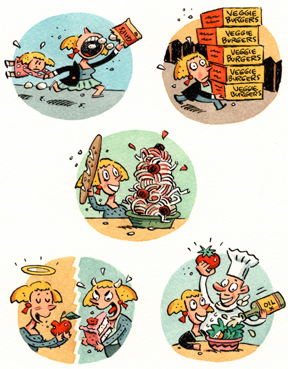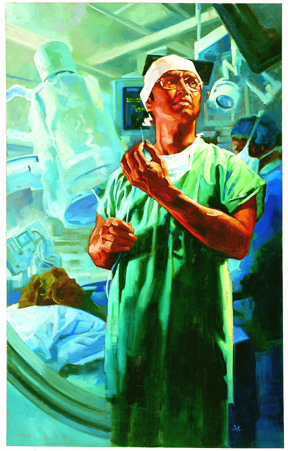
(845) 246-6944 ·
info@ArtTimesJournal.com
 “Doctor and Boy Looking at Thermometer”, Norman Rockwell 1954. Display advertisement for The Upjohn Company. o/c |
Rockwell
and his Legacy
at the Norman Rockwell Museum
By
RAYMOND J. STEINER
ART TIMES May 2007
IN
AN AGE where both mental and physical health seem progressively doomed
to be a thing of the past, “Picturing Health,” the present exhibition*
at the Norman Rockwell Museum, might be “just what the doctor ordered.”
If the exhibit cannot actually stem the almost daily tide of new diseases,
rampant drug abuse, pharmaceutical transgressions, hidden hospital horrors,
or demented acts of terrorism, it can offer the balm of nostalgia, a quiet
interlude in today’s increasingly violent and sickened world, a step into
a past where grey-haired doctors were friendly, fatherly types who wore
ties and vests and who seemed to genuinely care not only for your bodily
wounds and ills, but for you.
 “Healthy Eating”, Elwood Smith, 2000 Illustration for Healthy Living, Jan. 2000 Watercolor and ink on paper, Collection of the artist ©2000 Elwood Smith |
Whether
such a world actually did exist — Rockwell always claimed not to
paint reality, but “life as I would like it to be” — “Picturing
Health” does make it clear that, as a subject for art, human ailments
did certainly not begin — or end — with Norman Rockwell’s
famous illustrations of endearing doctors and their charming patients.
Examples from the past have a long history and, as this exhibit shows,
continues on to this day — and “picturing health” will probably
be alive and well long into the future.
Some forty-seven works — eleven by Rockwell — make up the show, those by such artists as Melinda Beck, Guy Billout, Juliette Borda, Cathie Bleck, Cora Lynn Deibler, Teresa Fasolino, Peter de Sčve, Frances Jetter, Gregory Manchess, Whitney Sherman, Elwood Smith, and Mark Ulriksen carrying on the tradition of health-related motifs if not Rockwell’s distinctive style of illustration. Although the gallery featuring original Rockwell paintings commissioned by the Pfizer Company — with its suite of the four photographs he used for his “Doctor and Boy Looking at a Thermometer” — dominates the exhibit — in both scale and technique, in the estimation of this viewer — the other works are by no means negligible. The untitled mural painting at the American College of Cardiologists in Washington, D.C., for example, is as fine as any of Rockwell’s illustrations if not as “homely” in its overall presence. It is, rather fittingly, “modern” in a high-tech kind of way, but flawlessly handled in an extremely sophisticated painterly manner. By contrast, most of the other works are “cartoony” in nature, meant for quick scansion and easy readability. Though all are effective in delivering their messages of “picturing health” — or
|
aspects
of it — at the same time, there exists a wide range of aesthetics
in artistic expression. The comic book characters of Elwood Smith, for
example, are a far cry from the black and white scratchboard illustrations
of Cathie Bleck. Whereas Smith’s comical characters render immediate understanding
to his viewers, Bleck’s — echoing as they do the early German woodcut
with its severe expression sans the mitigation of color — carry
with their ostensible message a somber reminder of the seriousness underlying
the human condition. Both work, but for very different aesthetic reasons,
since both are meant for different audiences.
On
several counts, then, “Picturing Health” is an exhibition well worth your
time to make the trip to Stockbridge, Massachusetts. Not only is it timely
— we could certainly use some of Rockwell’s gentle sensibility in
the face of an increasingly complex world that in Hamlet’s words seems
“out of joint” — but it is also instructive in artistic terms as
it shows a wide variety of approaches to a single theme.
The
Norman Rockwell Museum is always worth a visit — but kudos to Director
Laurie Norton Moffatt and Barry Winiker, curator of the Corporate Art
Collection, Pfizer, Inc., for organizing and presenting this show.
*“Picturing
Health: Norman Rockwell and the Art of Illustration” (thru May 28): Norman
Rockwell Museum, Rte 183, Stockbridge, MA (413) 298-4100
